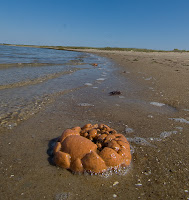
Location: Chincoteague and Assateague, Virginia
I visited my friend Aydin and his son, Erol who were weekending on Chincoteague. Chincoteague, a barrier island like Assateague, is somewhat famous for being the location of "Misty of Chincoteague," a book by Marguerite Henry ("A Wild, ringing neigh shrilled up from the hold of the Spanish galleon..."), that tells the story of a feral pony and her foal, Misty.
There are two separate pony herds on Assateague, one in Maryland, and one in Virginia. Each herd is managed by their respective rangers. I have seen many ponies here on Assateague Island in Maryland, but we were quite "ponyless" on the Virginia side!
 Besides walking the beach and along the shore of the cove -- and finding large, pinky-orange blobs of play-doh-like organisms washed up on the shore that turned out to be, of all things, "Sea Pork" -- we visited Assateague Lighthouse.
Besides walking the beach and along the shore of the cove -- and finding large, pinky-orange blobs of play-doh-like organisms washed up on the shore that turned out to be, of all things, "Sea Pork" -- we visited Assateague Lighthouse.
The following paragraph is a fictional recreation based on historical facts:
Imagine yourself in Congress in 1830. You can plainly understand that seafaring is a dangerous business, and running aground on barrier islands should be avoided. So you authorize a lighthouse to be built on Assateague. The builders come, the builders build, and you anxiously await the day when you can proudly dedicate this brand-spanking-new lighthouse and save untold numbers of registered voters from the heartbreak of death on the shoals. In 1833 it's finally ready. You stand on the shore at sunset, waiting for the piercing light to cut through the twilight as it searches for ships that would otherwise be lost in the night. You wait. You wait some more. Finally you shout, "TURN ON THE LIGHT!" And you hear the yelled reply, "ITS BEEN ON FOR HALF AN HOUR!" -- but since this new wonder of illumination is only 42 feet high, its light, from 11 candles with reflectors, can't exactly reach you, let alone the ships that are in danger of being ripped to shreds. For comparison, maple trees grow 30-130 feet. So much for THAT $55,000 of taxpayer money.
 Back to Congress we go, and another appropriation is made in 1859, this time for a 142 foot light house. Work began again, paused briefly during the Civil War, and finally was finished 1867. The new lighthouse was made of natural orange bricks and had a powerful Fresnel lens that successfully magnified the flame from a four-wick fish oil lamp so the beam shone far into the ocean. It was not until 1933 that the oil lamp was replaced by an electric light.
Back to Congress we go, and another appropriation is made in 1859, this time for a 142 foot light house. Work began again, paused briefly during the Civil War, and finally was finished 1867. The new lighthouse was made of natural orange bricks and had a powerful Fresnel lens that successfully magnified the flame from a four-wick fish oil lamp so the beam shone far into the ocean. It was not until 1933 that the oil lamp was replaced by an electric light.
 In 1963, the lighthouse was painted alternating stripes of red and white. Salt, water, and time have caused the paint to peal, orange brick showing through and giving the lighthouse a weathered patina. But it is a beautiful structure nonetheless, and we climbed the circular stairway all the way to the top. The original orange brick is still visible on the inside. The omni-directional Fresnel lens has been replaced by two rotating lights, but the climb and the view are identical to that experienced by the lighthouse keepers on a daily basis for decades and decades.
In 1963, the lighthouse was painted alternating stripes of red and white. Salt, water, and time have caused the paint to peal, orange brick showing through and giving the lighthouse a weathered patina. But it is a beautiful structure nonetheless, and we climbed the circular stairway all the way to the top. The original orange brick is still visible on the inside. The omni-directional Fresnel lens has been replaced by two rotating lights, but the climb and the view are identical to that experienced by the lighthouse keepers on a daily basis for decades and decades.
I'm glad Congress got it right the second time.

3 comments:
So? What is sea pork anyway?
You never said and I have never heard of it!
Karen
Sea pork is a colony of tiny organisms that are "stuck together" by a gelatinous substance that they secrete. I have no idea why they do this, but if there are any marine biologists out there, feel free to comment! The ranger did tell me that they are "in trouble" when they are out of the water, so the ones on the beach are probably dying.
Fish, birds, reptiles and mammals all belong to the taxanomic phylum Cordata. All these animals possess a notocord which is supporting a neural rod that in vertabrates (like us humans)develops into the spinal column. This notocord separates the Coradata from all the other animals (insects, spiders, worms, starfish, etc.). Sea Pork is a evolutionary go-between for those things without a backbone and those that do. Sea Pork is a Tunicate (Sea Squirt) and dispite its appearence is also a Cordate. There small tadpolelike bodies have notocords while all other invertebrates do not. They are in reality a close relative to us -- so be sure to show respect for what could well be on your ancestoral tree (admittedly a few generations back).
Post a Comment